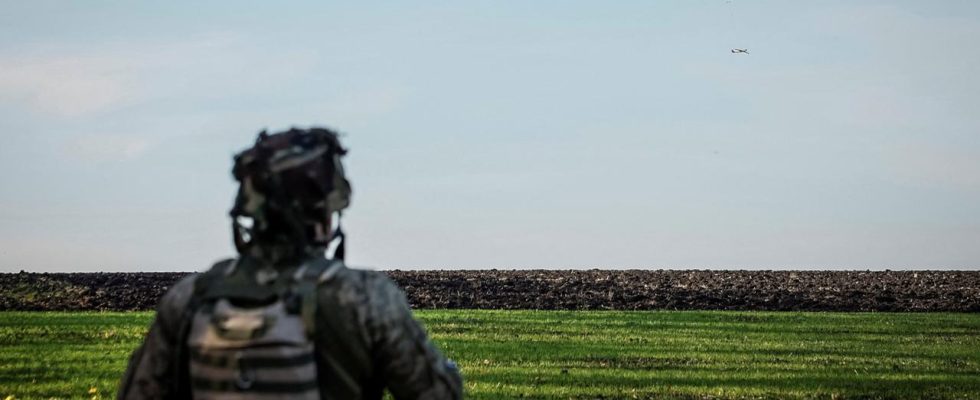analysis
The Ukrainian commander-in-chief Saluzhnyj states a stalemate in the war started by Russia. Is there a risk of a long trench war – and what does Ukraine need to go on the offensive?
The images that Ukrainian Supreme Commander Valeriy Zalushnyj is currently reminded of are more than a hundred years old. Back in the First World War, millions of soldiers fought in the trenches in Belgium and France. Despite the use of modern tanks, aircraft and other innovative weapons, the World War II armies were rarely able to achieve major breakthroughs.
Today the Russian attack troops and the Ukrainian army are facing each other in Europe. Both sides have dug in again and no major gains in ground have been made for months. “Just like in the First World War, we have reached a level of technology that puts us in a stalemate,” Saluzhny told the British magazine The Economist.
He warns of the risks of trench warfare. This could “drag on for years” and “wear down the Ukrainian state.”
Trench warfare or war of movement?
For military analyst Franz-Stefan Gady from the Institute for International Strategic Studies, however, the fighting on the Ukrainian battlefields is not yet a classic trench warfare. He continues to observe a “dynamic, still evolving situation.” In addition, it is normal in all military campaigns – not just in Ukraine – for different phases of the war to alternate.
As a result, wars of position can sooner or later turn into wars of movement again. In the course of the war so far, deep advances “into the rear of the enemy” have been “more of an exception,” said Gady.
The military analyst suspects that Ukrainian commander Saluzhny is still pursuing the goal of switching back to mobile warfare. With his statements, Saluzhnyi wants to create better conditions for Ukraine, says Gady: for example, through more Western military training, modern military technologies and supplies for artillery systems.
The ongoing question about weapons shipments
Nico Lange, Senior Fellow at the Munich Security Conference, also believes that the Ukrainian goal is to bring more movement back to the battlefields in the east and south of the country. To do this, Ukraine needs, among other things, “fighter aircraft and drones, tools to combat Russian artillery systems and better electronic warfare.”
Whether there will be a long-term trench war in Ukraine depends on “what and how quickly we deliver,” said Lange.
What Ukraine has achieved so far
The Ukrainian army has been trying to retake territory in an offensive for around five months. Limited breakthroughs were made through Russian fortifications in some towns in the Zaporizhzhia and Donetsk regions. Ukraine also repeatedly managed to carry out attacks on distant Russian military points behind the front.
However, there were no significant recaptures similar to last year this summer. Also because the Russian troops have entrenched themselves behind wide belts of mines and are repeatedly attacking, currently particularly around the city of Avdiivka.
Regarding the Ukrainian offensive, Lange says that “success cannot only be measured in square meters.” According to him, the offensive is “much more successful than many prophecies of doom say.” The military successes also include, for example, the fact that grain ships can once again leave the port city of Odessa and that Russian defensive positions could be broken even without air superiority.
“No alternative”
For military analyst Gady, however, the “geographical operational goals have not yet been achieved.” The Russian-occupied territory was neither split in two, nor were supply lines cut off. Even more important than the area of the recaptured terrain in this phase of the war was the “wear and tear on people and material,” said Gady.
However, an assessment of this is not possible because details and figures on the attrition of the two armies are missing. He observed that Russian forces suffered “enormous losses” during the Ukrainian offensive. There were only “few alternatives” for Ukraine in the war of attrition so as not to give the Russian army a breather.
The fights in winter
Both experts, Gady and Lange, assume that the fighting will continue in the coming winter months. Gady expects “local attacks and counterattacks,” but less large-scale offensives. Both sides will try to maintain their occupied positions as much as possible, said Gady. Trench warfare is possible, but “not completely frozen.”
Basically, Gady expects “difficult months for Ukraine”. The reason for this is gaps in artillery ammunition and air defense as well as bottlenecks in well-trained personnel.
He only sees “a light at the end of the tunnel” again in the second half of 2024, for example because of the Western training programs for Ukrainian soldiers and because of announced arms deliveries.
What do the F-16s do?
Lange comes to a different assessment. He expects “changes in favor of Ukraine” in the coming months. On the one hand, says Lange, because of the soon-to-be-deployed F-16 fighter jets that several European countries have promised Ukraine. On the other hand, Ukraine has greater mobility than in the previous year, thanks to more tracked vehicles.
Lange also warns against applying “historical ideas about the Winter War” to the current conflict. The cold would “not automatically help” Russia.
Modernity Military technology decisive
Lange and Gady agree that modern military technology will play a key role in future battles. Ukrainian General Zalushnyj also believes, according to The Economist, that “technology will be decisive,” not through a single new innovation, but “a combination of all existing technical solutions.”
According to Lange, Saluschnyj means “data-driven warfare, precision weapons such as US ATACMS or British Storm Shadows, but also masses of air and surface drones.” In particular, the long-range weapons, when used effectively in conjunction with other weapons, can open up great tactical opportunities, according to military analyst Gady.
But it is an illusion to believe that “individual weapons or individual missiles alone will be decisive.”

